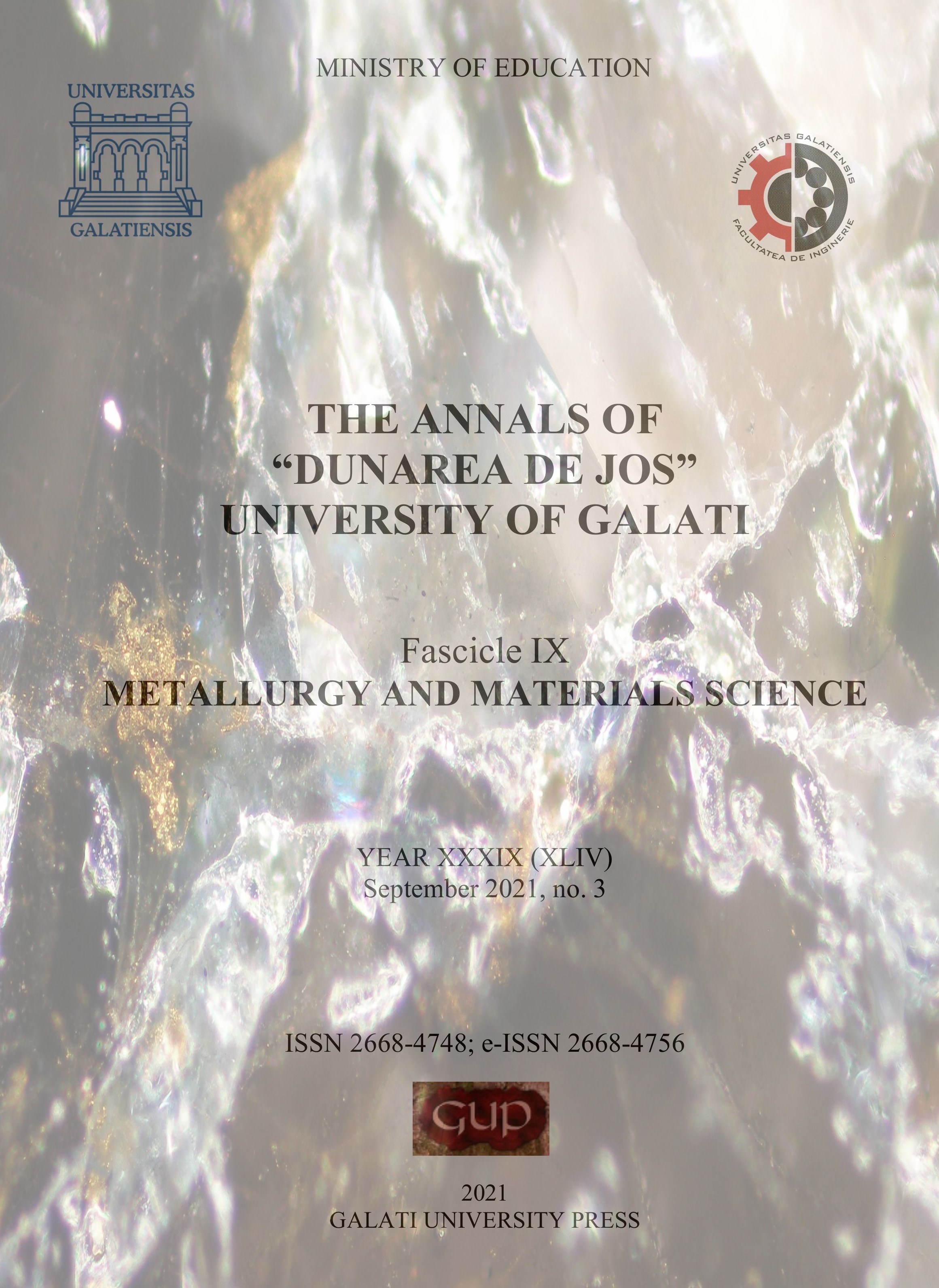Application of the Natural Cellulosic Supports for the Treatment of the Industrial Effluents
Abstract
Wastewater treatment is one of the most important concerns of the research studies in the field of environmental protection. The current study relates to the removal of Crystal violet dye from aqueous solutions through adsorption experiments onto natural cellulosic supports.
Various waste materials that have in their composition lignocellulose are adsorbent supports with low costs for the removal of heavy metal ions and dyes from aqueous solutions.
The use of chemically modified sawdust to obtain an inexpensive adsorbent for removing the Crystal violet dye (CV) from synthetic aqueous solutions has been presented in this research paper. The influence of some important parameters such as: initial dye concentration, adsorbent dose, contact time and temperature on adsorption efficiency for this dye removal have been studied. The Freundlich, Langmuir and Temkin mathematical models have been used to evaluate the data of Crystal violet adsorption from aqueous media using wood sawdust.
The research study shows that beech wood sawdust (Fagus sylvatica), as an agricultural waste which is readily available and relatively inexpensive has the potential to be an applicable alternative adsorbent for Crystal violet dye removal from industrial effluents.
Downloads
References
[2]. Amarasinghe B. M., Williams R. A., Tea waste as a low-cost adsorbent for the removal of Cu and Pb from wastewater, Chemical Engineering Journal, 132 (1-3), p. 299-309, 2007.
[3]. Wanyonyi W. C., Onyari J. M., Shiundu P. M., Adsorption of congo red dye from aqueous solutions using roots of eichhornia crassipes: kinetic and equilibrium studies, Energy Procedia, 50, p. 862-869, 2014.
[4]. Oguntimein G. B., Biosorption of dye from textile wastewater effluent onto alkali treated dried sunflower seed hull and design of a batch adsorber, J. Environ. Chem. Eng., 3(4), p. 2647-2661, 2015.
[5]. Martins L., Vieira Rodrigues J., Herrera Adarme O., Sacramento Melo T., Gurgel L., Gil L., Optimization of cellulose and sugarcane bagasse oxidation: Application for adsorptive removal of crystal violet and auramine-O from aqueous solution, Journal of Colloid and Interface Science, 494, p. 223-241, doi: 10.1016/j.jcis.2017.01.085, 2017.
[6]. Gilbert K., Wycliffe C., Joyce J., Esther N. M., Adsorption of toxic crystal violet dye using coffee husks: Equilibrium, kinetics and thermodynamics study, Scientific African, 5, p. 1-11, 2019.
[7]. Bombos D., Ganea R., Matei V., Marinescu C., Bondarev A., Mihai S., Natu T., Tamas I., Modified Bentonite for Purification of Dyeing Waste WaterRev, Chim., 65 (8), p. 976-982, 2014.
[8]. Lafi R., Rezma S., Hafiane A., Removal of toluidine blue from aqueous solution using orange peel waste (OPW), Desalin. Water Treat., 56(10), p. 1-12, 2014.
[9]. Razmovski R., Ciban M., Biosorption of Cr(VI) and Cu(II) by waste tea fungal biomass, Ecological Engineering, 34(2), p. 179-186, 2008.
[10]. Rajeswari M., Revanth T., Aniruth A., Prasad B., Removal of Crystal Violet dye from aqueous solution using water hyacinth: Equilibrium, kinetics and thermodynamics study, Resource-Efficient Technologies, 3 (1), p. 71-77, 2017.
[11]. Hou S., Adsorption properties of pomelo peels against methylene blue in dye wastewater, Adv. Mater. Res., 634-638, p. 178-181, 2013.
[12]. Erfani M., Javanbakht V., Methylene Blue removal from aqueous solution by a biocomposite synthesized from sodium alginate and wastes of oil extraction from almond peanut, Int. J. Biol. Macromol, 114, p. 244-255, 2018.
[13]. Rominiyi O., Adaramola B., Ikumapayi O., Potential Utilization of Sawdust in Energy, Manufacturing and Agricultural Industry: Waste to Wealth, World Journal of Engineering and Technology, 05(03), p. 526-539, 2017.
[14]. Bondarev A, Gheorghe C. G, Gheorghe V., Bombos M., Removal of Dyes from Textile Wastewater Using Sawdust as Low-cost Biosorbent, Rev. Chim., 71 (3), p. 387-396, 2020.
[15]. Apafaian A. I., Proto A. R., Borz S. A., Performance of a mid-sized harvester-forwarder system in integrated harvesting of sawmill, pulpwood and firewood, Ann. For. Res., 60(2), p. 227-241, doi: 10.15287/afr.2017.909, 2017.
[16]. Bello K., Sarojini B. K., Narayana B., Rao A., Byrappa K., A study on adsorption behavior of newly synthesized banana pseudo-stem derived superabsorbent hydrogels for cationic and anionic dye removal from effluents, Carbohydr. Polym., 181, p. 605-615, doi: 10.1016/j.carbpol.2017.11.106, 2018.
[17]. Monda L., M. K., Removal of Pb(II) ions from aqueous solution using activated tea waste: Adsorption on a fixed-bed column, Journal of Environmental Management, 90(11), p. 3266-3271, 2009.



